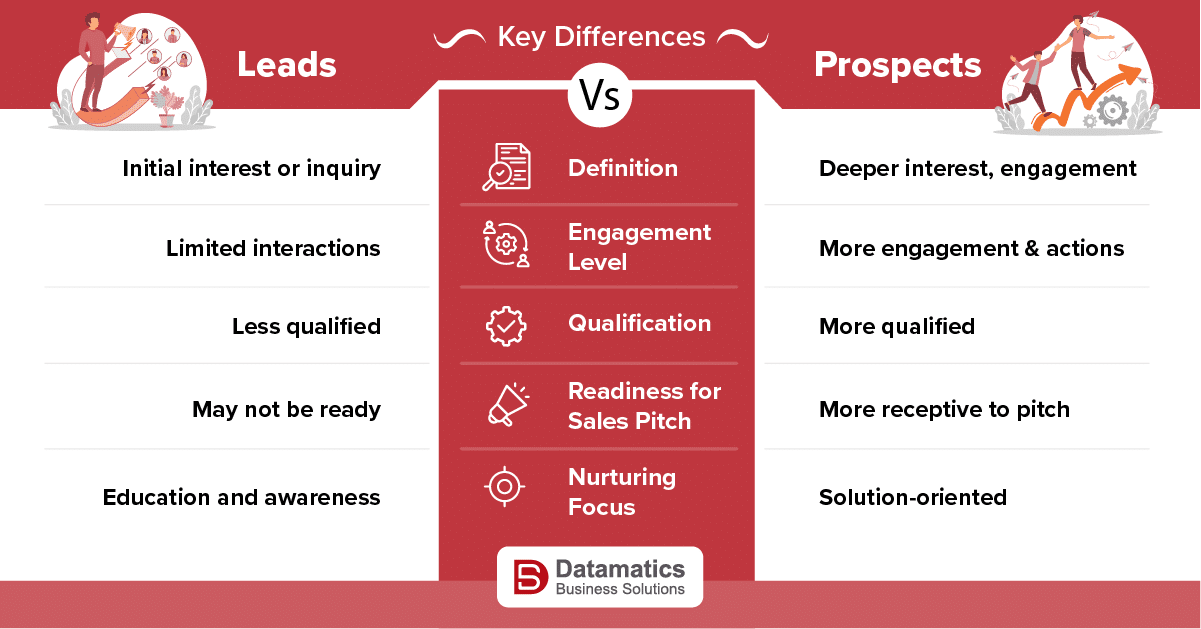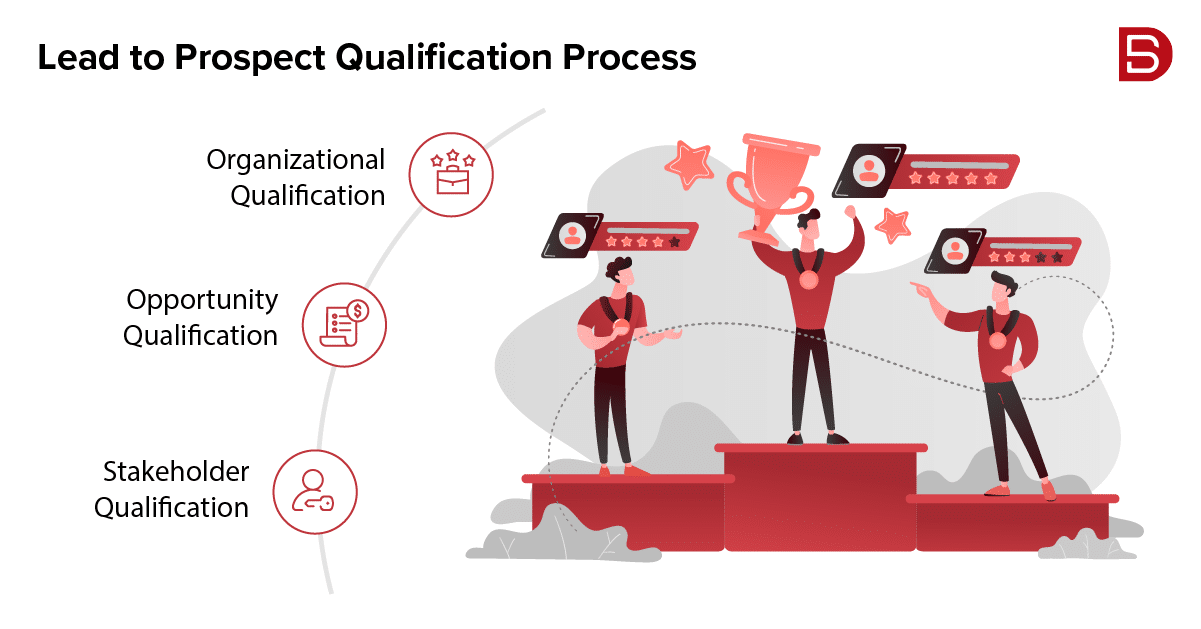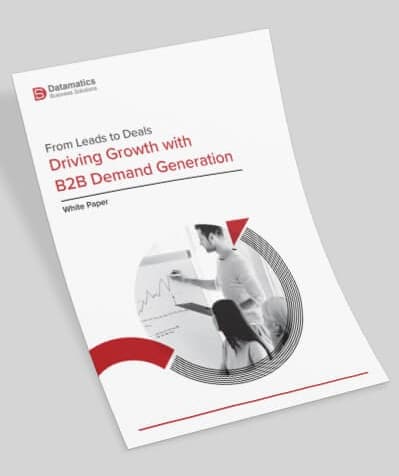Ever found yourself in a sales or marketing conversation and wondered, “What’s the real difference between a ‘lead’ and a ‘prospect’?” You’re not alone. It’s essential to be able to tell the difference between leads vs. prospects. Why, you ask? Well, these terms hold distinct meanings, and are positioned at different stages within your sales funnel.
Using a one-size-fits-all approach for both leads and prospects might lead to missed opportunities, as what works for one category might not work for the other. In this blog, we’ll go over different nuances of leads vs. prospects, including their definitions, differences, and tips to effectively convert the former into the latter. So, let’s get started.
What is a Lead?
A lead is a potential business or individual who has shown interest in your products or services. Leads are typically at an early stage of the sales process and may have engaged with your business through various actions, such as visiting your website, downloading content, attending webinars, or expressing interest in your offerings. They’re not quite ready to buy yet, but they’re thinking about it.
Your job is to nurture and educate them until they’re ready to take the plunge and become paying customers. That’s when they move up the ladder and become a “prospect.” So, leads are the starting point in the journey from curiosity to becoming your customer.
What is a Prospect?
A prospect is a stage along the journey where potential customers are actively considering a purchase. They’re not just window shopping; they’re doing the groundwork.
Prospects find themselves in the consideration stage of the sales funnel. Here, they are on a mission, seeking product details, comparing options, checking prices, reading reviews, and essentially becoming experts in what they want.
But even though they’re seriously thinking about a purchase, it’s not entirely clear if your products or services are the perfect fit for them.
So, how do we identify these prospects? Well, marketing and sales teams have their methods. Once spotted, the focus shifts to nurturing them. This involves aiding them in their buying journey and fostering a strong connection to your brand. It’s all about building that connection!
Leads Vs. Prospects: The Fine Line Defined
If you’re in business development, marketing, or sales, you’ve likely come across the terms “lead” and “prospect.” What’s interesting is that many folks tend to use these words interchangeably, but they’re not one and the same.
Leads are potential customers who have demonstrated an interest in your products or services. They might have downloaded an e-book, subscribed to your newsletter, or visited your website.
On the flip side, prospects are leads who have gone a step further by expressing a specific desire to learn more about what you offer. They’ve engaged with your sales or marketing team. Because prospects have shown a deeper level of interest, they’re more likely to become customers than regular leads.
Prospects are leads that have been evaluated and have a high likelihood of becoming paying customers. Qualifying a prospect typically involves considering factors like their budget, timing, authority, need, and alignment with your offerings.
In a nutshell, leads are potential customers who have shown interest, while prospects are leads with a higher probability of becoming paying customers. So, the key distinction lies in the likelihood of conversion – prospects have a greater chance of becoming paying clients compared to regular leads. To effectively manage and convert these prospects, consider outsourcing your lead generation services for expert assistance in nurturing and converting these valuable prospects into loyal customers.
Converting Leads into Prospects: The Qualifying Process
The key to transforming a lead into a prospect lies in the art of qualification, a three-stage journey that not only enhances the chances of them becoming a customer but also ensures they’re the right fit for what you offer.
A lead takes on the title of a qualified prospect when they progress through this process and respond positively to your outreach.
Here’s the lowdown on what every sales and marketing rep should know about the lead qualification process:
1. Organizational Qualification
The journey begins at the organizational level. You need to align your lead with the buyer persona your business has crafted. How do you make sure they’re a match for your organization’s ideal customer? You address questions like:
- What industry does the company operate in?
- Where is its headquarters?
- How many employees make up the company?
- Does it have the financial capacity to afford your services, as indicated by factors like funding rounds, M&A activity, and company size?
- Does the company truly need your services, or are they already using a competitor’s solution?
Without meeting these criteria, even if you engage with a motivated and interested prospect, you won’t be able to show how your solution can bring immediate benefits to their business’s bottom line. Failure to pass this qualification round means you won’t proceed to a successful transaction. This is where lead generation companies can play a pivotal role in identifying and connecting you with leads that meet your ideal customer profile, ensuring your efforts are focused on prospects with the highest likelihood of conversion.
2. Opportunity Qualification
Once you’ve covered the organizational basics, and now it’s time to evaluate the opportunity. In simple terms, you’re figuring out if the lead’s company actually needs what you’re offering. But it doesn’t stop there, you’re also exploring whether your product or service would genuinely benefit their company.
Opportunity qualification revolves around showcasing a genuine interest in your prospect’s business. You should have a checklist of the important details you want to gather because not every contact will spill all the beans right away.
If you can’t provide a clear, concise pitch about how your solution can benefit their business and a plan for how to make it happen, the chances of turning that lead into a customer drop significantly. So, this phase is about making sure your prospect can clearly see the value in what you bring to the table.
Master the Art of Lead Qualification
Identify, nurture & convert leads
Download the eBook
3. Stakeholder Qualification
Once you’ve made it through the previous steps, the next step is ensuring the lead aligns with your ideal customer persona and stands to benefit from what you offer. But before you go further, you need to make sure they have the authority to give the green light to a final purchase decision.
If they don’t hold the decision-making power, you might need to identify the right stakeholder who can carry the torch forward in the sales process.
Conclusion
When it comes to gaining an edge over your competitors, every sales or marketing pro should have a clear grasp of leads vs. prospects. Prospects are those individuals who, after being nurtured through your sales process, show a stronger likelihood of conversion. Whereas leads are those potential customers who’ve just kindled their interest in what you have to offer.
Understanding these distinctions can help you fine-tune your ROI and supercharge your conversion rates. With this insight, you can rest assured that you’re covering all the bases to seal the deal either of them! If you wish to accelerate your sales efforts, don’t hesitate to reach out to us at marketing@datamaticsbpm.com. Let’s turn those leads into prospects and prospects into loyal customers!
 Select an element to maximize. Press ESC to cancel.
Select an element to maximize. Press ESC to cancel.
Paul van de Kamp




